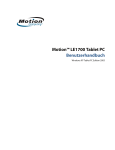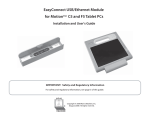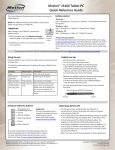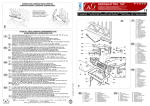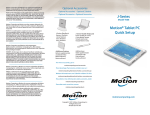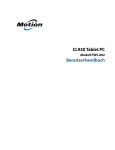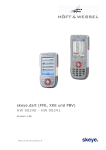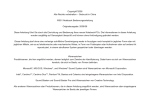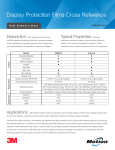Download Motion Computing MotionTM C5 User's Manual
Transcript
C5_DockingStation.book Page i Friday, June 1, 2007 2:07 PM Motion™ C5 Docking Station User’s Guide Motion™ C5 Station d’accueil Guide de l’utilisateur Motion™ C5 Docking-Station Benutzerhandbuch C5_DockingStation.book Page ii Friday, June 1, 2007 2:07 PM © 2007 Motion Computing, Inc. All rights reserved. This document contains information protected by copyright. No part of this document may be reproduced in any form without written consent from Motion. The information in this document is provided “as is” and is subject to change without notice. Motion is not liable for errors or omissions in this document. Motion, Motion Computing, Speak Anywhere, and View Anywhere are trademarks or registered trademarks of Motion Computing, Inc. in the U.S.A. and other countries. Microsoft Windows, Windows XP, Windows XP Tablet PC Edition, and Windows Journal are trademarks or registered trademarks of Microsoft Corporation in the United States and/or other countries. Motion Computing, Inc. has made every effort to identify trademarked properties and owners on this page. All brands and product names used in this document are for identification purposes only and may be trademarks or registered trademarks of their respective companies. The warranties for Motion products are set forth in the express limited warranty statements accompanying such products. Nothing in this document constitutes an additional warranty. The Motion Computing products and services may be covered by one or more patent-protected inventions. Additional patents may also be pending. For more information, see www.motioncomputing.com/info/patents.asp. © 2007 Motion Computing, Inc. Tous droits réservés. Les informations du présent document sont protégées par des droits d’auteur. Aucun élément du présent document ne peut être copié ou reproduit sous quelque forme que ce soit sans l’accord écrit de Motion. Les informations du présent document sont fournies « en l’état » et peuvent faire l’objet de modifications sans préavis. Motion ne peut être tenu responsable des erreurs ou omissions dans ce document. Motion, Motion Computing, Speak Anywhere et View Anywhere sont des marques commerciales ou des marques déposées de la société Motion Computing, Inc. aux Etats-Unis et dans d’autres pays. Microsoft Windows, Windows XP, Windows XP Tablet PC Edition et Windows Journal sont des marques commerciales ou des marques déposées de la société Microsoft Corporation aux Etats-Unis et/ou dans d’autres pays. Motion Computing, Inc. a fait en sorte d’identifier les appartenances et les propriétaires des marques déposées et commerciales. Les marques et les noms PN 024-02-0153 Revision A00 April 2007 de produits mentionnés dans le présent document sont désignés exclusivement à des fins d’identification et peuvent être des marques commerciales ou déposées appartenant à leurs propriétaires respectifs. Les garanties relatives aux produits, consenties par Motion, sont spécifiées dans les clauses de garantie limitée accompagnant les produits concernés. Aucun élément du présent document ne constitue une garantie complémentaire. Les produits et services de Motion Computing peuvent être protégés par une ou plusieurs inventions brevetées. D’autres brevets peuvent être en cours de certification. Pour plus d’informations, consultez le site www.motioncomputing.com/info/patents.asp. © 2007 Motion Computing, Inc. Alle Rechte vorbehalten. Dieses Dokument enthält urheberrechtlich geschützte Informationen. Kein Teil dieses Dokuments darf ohne schriftliche Genehm-igung von Motion reproduziert werden. Die Informationen in diesem Dokument werden in ihrem derzeitigen Zustand zur Verfügung gestellt und unterliegen unangekündigten Änderungen. Motion haftet nicht für Fehler oder Auslassungen in diesem Dokument. Motion, Motion Computing, Speak Anywhere und View Anywhere sind Marken oder eingetragene Marken von Motion Computing, Inc. in den USA und anderen Ländern. Microsoft Windows, Windows XP, Windows XP Tablet PC Edition und Windows Journal sind Marken oder eingetragene Marken von Microsoft Corporation in den Vereinigten Staaten und/oder anderen Ländern. Motion Computing, Inc. war bestrebt, sämtliches Markeneigentum und deren Inhaber auf dieser Seite zu erwähnen. Alle Marken und Produktnamen in diesem Dokument dienen ausschließlich Identifizierungszwecken und können Marken oder eingetragene Marken ihrer jeweiligen Unternehmen sein. Die Garantien für Motion-Produkte sind in den Erklärungen zur eingeschränkten Garantie ausgeführt, die den Produkten beiliegen. Die Informationen in diesem Dokument stellen keine zusätzliche Garantie dar. Die Motion Computing-Produkte und Dienstleistungen können einer oder mehreren der folgenden durch Patente geschützten Erfindungen unterliegen. Weitere Patente sind angemeldet. Weitere Informationen erhalten Sie unter www.motioncomputing.com/info/patents.asp. C5_DockingStation.book Page 1 Friday, June 1, 2007 2:07 PM C5 Docking Station The Motion C5 Docking Station provides enhanced functionality for your C5. The Docking Station includes port expansion for keyboards, printers, external monitors, Ethernet connectivity, and other USB devices. Also, the Docking Station charges the C5 and includes a charging bay for an additional battery. For more information about peripherals and options, go to www.motioncomputing.com. C5 in the Docking Station English 1 C5_DockingStation.book Page 2 Friday, June 1, 2007 2:07 PM Placing and mounting the C5 Docking Station The C5 Docking Station can be placed on a desk or table or mounted to a wall or other equipment such as an arm mount or cart. The bottom of the Docking Station contains a standard VESA mounting pattern that can be used with other VESA-compatible equipment such as an arm mount, wall mount, or cart. Note: Certain mounting configurations may require other components such as a wall bracket. Also, the Docking Station includes a security slot for locking the Docking Station. Placing on a desk When using the Docking Station on a desk or table, place the Docking Station approximately 4 inches from a wall to enable easy access to the spare battery. Depending on the intended use, you can adjust the viewing angle of the Docking Station to three different angles: 15°, 25°, or 38°. For more information about viewing angles, see “Setting the viewing angle” on page 8. Mounting to a wall Mounting the Docking Station to a wall requires a separate wall bracket that is compatible with a 75 mm VESA-pattern mount. To minimize the distance the Docking Station projects from the wall, Motion recommends that you rotate the viewing angle to 38°. The wall bracket must facilitate this angle to keep the C5 in a vertical orientation. 2 English C5_DockingStation.book Page 3 Friday, June 1, 2007 2:07 PM Mounting to a cart or mounting arm Mounting the Docking Station to a cart or mounting arm requires a VESA-compatible mount to interface with the 75 mm VESA hole pattern on the bottom of the Docking Station. For information about viewing angles of the Docking Station, see “Setting the viewing angle” on page 8. To mount the C5 Docking Station 1. The C5 Docking Station includes four 75 mm VESA-compatible mounting holes. For specific mounting requirements for your wall mount, mounting arm, or cart, refer to your mounting equipment instructions. 2. If using a VESA mount, fasten the Docking Station to the VESAcompatible equipment with four M4 screws, 12 mm maximum length. VESA mounting holes on the bottom of the Docking Station English 3 C5_DockingStation.book Page 4 Friday, June 1, 2007 2:07 PM Connecting the C5 Docking Station The Docking Station includes ports for extending the capabilities of your C5 and charging the battery. To connect to the Docking Station ports 1. Connect the AC power adapter according to the illustration below. 4 English C5_DockingStation.book Page 5 Friday, June 1, 2007 2:07 PM 2. Connect peripherals such as a keyboard or mouse to the USB ports. Note: The USB ports on the Docking Station can be powered by battery or AC power. To secure the Docking Station, you can use a compatible lock in the security slot. AC power port USB ports Ethernet port Security slot VGA port English 5 C5_DockingStation.book Page 6 Friday, June 1, 2007 2:07 PM Using the C5 Docking Station After you have mounted the Docking Station and attached peripherals, you can use the Docking Station to enhance the performance of your C5. Reading the status lights The lights on the front of the Docking Station indicate its status. Status lights Green = C5 is docked Off = C5 is not docked Amber = Spare battery in battery bay is charging Green = Spare battery is charged Off = Spare battery is not docked 6 English C5_DockingStation.book Page 7 Friday, June 1, 2007 2:07 PM Docking and removing the C5 You can easily insert and remove the C5 from the Docking Station. To dock the C5 • Gently slide the C5 into the Docking Station. The C5 locks into place when cradled securely. The green docking light indicates a successful dock. English 7 C5_DockingStation.book Page 8 Friday, June 1, 2007 2:07 PM To remove the C5 The C5 can be removed from the Docking Station in two ways: • Press the eject button, and then pull the C5 out of the Docking Station. Eject button • Hold the Docking Station with one hand and pull the C5 out of the Docking Station. When removing the C5, you will feel some resistance; this is normal. Setting the viewing angle You can adjust the viewing angle of the Docking Station to 15°, 25°, or 38°. To set the viewing angle 1. Press the viewing angle button. Viewing angle button 2. Rotate the front of the Docking Station forward or backward to the desired viewing angle. When the station reaches a viewing angle, it locks into place. When the Docking Station is used only for charging the C5 battery or the spare battery, set the viewing angle to 15° to save space and improve stability. For keyboard use with a C5 docked in the Docking Station, set the viewing angle to 25° or 38°. 8 English C5_DockingStation.book Page 9 Friday, June 1, 2007 2:07 PM Locking the Docking Station The security slot locks the Docking Station only, not the C5. To lock the Docking Station 1. Locate the security slot on the Docking Station. Security slot 2. Open and place your lock in the security slot. 3. Attach the lock cable to a desk, cart, or other object. Secure the lock and lock cable according to the manufacturer instructions. Depending on the type of lock, you may need to loop, connect, or place a lock through the cabling. English 9 C5_DockingStation.book Page 10 Friday, June 1, 2007 2:07 PM Using an external monitor and projector You can connect the Docking Station to a VGA monitor or projector for presentations. Your C5 supports various external monitor configurations, including extended and mirror display. To use a VGA monitor 1. Plug the monitor cable into the VGA port on the Docking Station. VGA port 2. Plug the monitor or projector into a power outlet and turn it on. Windows XP or Vista will recognize the monitor and search for its hardware driver. You may need to install the driver from the CD supplied by the monitor's manufacturer. 3. By default, the content on the C5 will display to the monitor or projector. You can change the behavior of the external display in the Motion Dashboard. See the C5 User’s Guide for information about changing display configurations using the Motion Dashboard. 10 English C5_DockingStation.book Page 11 Friday, June 1, 2007 2:07 PM Using the battery charging bay The battery charging bay at the rear of the Docking Station enables simultaneous charging of the C5 and an additional battery. You can change the battery in the charging bay while a C5 is docked and in use (hot-swappable) or when a C5 is not docked (warm-swappable). WARNING: While charging the battery during hot-swapping, avoid lifting the C5 and disconnecting the C5 from the docking connector on the Docking Station, which will cause a power loss to the C5. When the Docking Station is used only for charging the C5 battery and spare battery, set the viewing angle to 15° to save space and improve stability. Battery in the charging bay Note: For information about the status lights and the battery charging states, see “Reading the status lights” on page 6. • To charge the C5, place the C5 into the Docking Station. • To charge an additional battery, insert a battery securely into the battery charging bay. Note: The spare battery continues to charge when the C5 is not in the Docking Station. English 11 C5_DockingStation.book Page 12 Friday, June 1, 2007 2:07 PM Warranty This product comes with a limited warranty: to see details about this limited warranty, go to www.motioncomputing.com. Safety and regulatory For general safety information, see the Safety and Regulatory Guide packaged with your C5. FCC Notice (United States): This equipment has been tested and found to comply with the limits for a Class B digital device, pursuant to part 15 of the FCC rules. These limits are designed to provide reasonable protection against harmful interference in a residential installation. This equipment generates, uses and can radiate radio frequency energy and, if not installed and used in accordance with the instructions, may cause harmful interference to radio communications. However, there is no guarantee that interference will not occur in a particular installation. If this equipment does cause harmful interference to radio or television reception, which can be determined by turning the equipment off and on, the user is encouraged to try to correct the interference by one or more of the following measures: • Reorient or relocate the receiving antenna. • Increase the separation between the equipment and the receiver. • Connect the equipment into an outlet on a circuit different from that to which the receiver is connected. • Consult the dealer or an experienced radio/TV technician for help. IC Notice (Canada): The C5 Docking Station is classified by the Industry Canada (IC) Interference-Causing Equipment Standard #3 (ICES-003) as Class B digital devices. This classification is located on the label on the bottom of the C5 Docking Station. Look for a statement on the label similar to the following: Canada ICES-003, Class/Classe B. This Class B (or Class A, if so indicated on the registration label) digital apparatus meets the requirements of the Canadian Interference-Causing Equipment Regulations. 12 English C5_DockingStation.book Page 13 Friday, June 1, 2007 2:07 PM CE Notice (European Notice): The Conformité Européne symbol found on the C5 Docking Station indicates compliance to the EMC Directive and the Low Voltage Directive of the European Union. This means that the C5 or Docking Station meets the following technical standards: EN 55022 (CISPR22), EN 55024 (CISPR 24) (IEC 61000 4-2, 4-3, 4-3, 4-5, 4-6, 4-8, 4-11), EN 61000 32 (IEC 61000 3-2), EN 61000 3-3 (IEC 61000 3-3), EN60950 (IEC 60950 3rd Ed; 1999; 2000). Service and support For service and support, go to www.motioncomputing.com/support. Patents The Motion Computing products and services may be covered by one or more protected inventions. For more information, see www.motioncomputing.com/info/patents. English 13 C5_DockingStation.book Page 14 Friday, June 1, 2007 2:07 PM 14 English C5_DockingStation.book Page 15 Friday, June 1, 2007 2:07 PM Station d’accueil C5 La station d’accueil C5 Motion propose des fonctionnalités améliorées pour votre C5. Cette station comprend une extension de port pour claviers, imprimantes, moniteurs externes, connectivité Ethernet et autres périphériques USB. En outre, la station d’accueil permet de charger la C5 et inclut une baie de chargement pour une batterie supplémentaire. Pour plus d’informations sur les périphériques et les options disponibles, rendez-vous sur le site www.motioncomputing.com. C5 dans la station d’accueil Français 15 C5_DockingStation.book Page 16 Friday, June 1, 2007 2:07 PM Positionnement et montage de la station d’accueil C5 La station d’accueil C5 peut être placée sur un bureau ou une table ou être montée sur un mur ou tout autre équipement de type accoudoir ou chariot. La partie inférieure de la station contient un élément de montage VESA standard, pouvant être fixé sur d’autres équipements compatibles VESA (accoudoir, support mural, chariot). Remarque : Des composants complémentaires peuvent être requis sur certaines configurations de montage, par exemple un crochet mural. En outre, la station d’accueil possède une fente de sécurité, permettant de protéger la station à l’aide d’un cadenas. Installation sur un bureau Lorsque vous utilisez la station d’accueil sur un bureau ou une table, placez-la à 10 cm d’un éventuel mur, pour pouvoir accéder facilement à la batterie de rechange. Suivant l’utilisation, vous avez le choix entre trois angles de vision différents pour la station : 15°, 25° ou 38°. Pour plus d’informations sur les angles de vision, consultez la section « Définition des angles de vision », page 22. Montage mural Pour fixer la station d’accueil au mur, vous devez utiliser un crochet mural (non fourni) compatible avec un support VESA 75 mm. Pour réduire au maximum la distance de projection de la station par rapport au mur, Motion recommande d’utiliser un angle de vision de 38°. Le crochet mural choisi doit permettre un tel angle pour que la C5 soit orientée verticalement. 16 Français C5_DockingStation.book Page 17 Friday, June 1, 2007 2:07 PM Montage sur un chariot ou un accoudoir Pour monter la station d’accueil sur un chariot ou un accoudoir, vous devez utiliser un support compatible VESA, qui servira d’interface avec le support à trou VESA 75 mm de la station. Pour plus d’informations sur les angles de vision de la station d’accueil, consultez la section « Définition des angles de vision », page 22. Pour monter la station d’accueil C5 1. La station d’accueil C5 est dotée de plusieurs trous de montage compatibles VESA de 75 mm. En cas de configuration de montage spécifique, que ce soit pour un montage mural, sur un accoudoir ou sur un chariot, reportez-vous aux instructions de montage de l’équipement. 2. Si vous utilisez un support VESA, fixez la station d’accueil à l’équipement compatible VESA à l’aide de quatre vis M4, d’une longueur maximum de 12 mm. Trous de montage VESA situés en dessous de la station d’accueil Français 17 C5_DockingStation.book Page 18 Friday, June 1, 2007 2:07 PM Connexion de la station d’accueil C5 La station possède des ports permettant d’étendre les capacités de la C5 et de recharger la batterie. Pour se brancher sur les ports de la station d’accueil 1. Branchez l’adaptateur secteur conformément à l’illustration ci-dessous. 18 Français C5_DockingStation.book Page 19 Friday, June 1, 2007 2:07 PM 2. Branchez les périphériques souhaités (clavier ou souris) sur les ports USB. Remarque : Les ports USB de la station d’accueil peuvent être alimentés par batterie ou sur secteur. Pour sécuriser votre station d’accueil, insérez un cadenas compatible dans la fente de sécurité. Port pour alimentation CA Ports USB Port Ethernet Fente de sécurité Port VGA Français 19 C5_DockingStation.book Page 20 Friday, June 1, 2007 2:07 PM Utilisation de la station d’accueil C5 Une fois la station montée et les principaux périphériques branchés, vous pouvez utiliser la station pour améliorer les performances de votre C5. Description des voyants d’état Le panneau de contrôle de la station d’accueil comprend plusieurs voyants d’état. Voyants d’état Vert = la C5 est placée sur la station Eteint = la C5 n’est pas placée sur la station Orange = la batterie de rechange est en cours de chargement dans la baie Vert = la batterie de rechange est chargée Eteint = la batterie de rechange est absente 20 Français C5_DockingStation.book Page 21 Friday, June 1, 2007 2:07 PM Placement et retrait de la C5 Pour placer la C5 sur la station • Faites glisser délicatement la C5 dans la station d’accueil. La C5 doit se bloquer lorsqu’elle est correctement mise en place. Le voyant vert s’allume alors, à gauche du voyant d’état. Français 21 C5_DockingStation.book Page 22 Friday, June 1, 2007 2:07 PM Pour retirer la C5 de la station Il existe deux méthodes pour sortir la C5 de la station d’accueil : • Appuyez sur le bouton d’éjection, puis tirez la C5 hors de la station. Bouton d’éjection • Tout en maintenant la station d’une main, tirez sur la C5 pour la sortir. Lors du retrait de la station d’accueil, il est normal de sentir une résistance. Définition des angles de vision Suivant l’utilisation, vous avez le choix entre trois angles de vision différents pour la station : 15°, 25° ou 38°. Pour définir l’angle de vision 1. Appuyez sur le bouton Angle de vision. Bouton Angle de vision 2. Faites pivoter la partie avant de la station vers l’avant ou vers l’arrière, jusqu’à obtenir l’angle approprié. Lorsque la station atteint un angle prédéfini, elle se bloque. Si vous utilisez la station uniquement pour recharger et économiser la batterie de votre C5, choisissez un angle de 15° pour gagner de l’espace et optimiser la stabilité. Si vous utilisez un clavier avec votre station, lorsque la C5 est insérée, choisissez un angle de 25° ou 38°. 22 Français C5_DockingStation.book Page 23 Friday, June 1, 2007 2:07 PM Verrouillage de la station d’accueil Ce cadenas protège uniquement la station et non la C5. Pour verrouiller la station d’accueil 1. Localisez la fente de sécurité de la station. Fente de sécurité 2. Ouvrez votre cadenas et insérez-le dans la fente. 3. Pour sécuriser la station, fixez le câble du cadenas au bureau ou à un chariot. 4. Suivant le type de cadenas, il peut être nécessaire d’utiliser une boucle, un raccord ou de passer le cadenas dans le câblage. Fixez le cadenas et son câble conformément aux instructions du fabricant. Français 23 C5_DockingStation.book Page 24 Friday, June 1, 2007 2:07 PM Utilisation d’un moniteur externe et d’un projecteur Vous pouvez brancher la station d’accueil à un moniteur VGA ou à un projecteur, afin de réaliser des présentations. Votre C5 prend en charge plusieurs configurations de moniteur externe, notamment en affichage étendu et en miroir. Pour utiliser un moniteur VGA 1. Branchez le câble du moniteur sur le port VGA de la station d’accueil. Port VGA 2. Branchez le moniteur sur une prise secteur et mettez-le en marche. Windows XP ou Vista reconnaît le moniteur et recherche son pilote matériel. Il se peut que vous deviez installer le pilote à partir du CD fourni par le fabricant du moniteur. 3. Par défaut, le contenu de la C5 s’affiche sur le moniteur ou le projecteur. Vous pouvez changer la configuration de l’écran externe dans Motion Dashboard. Consultez le Guide d’utilisateur de la C5 pour plus d’informations sur la modification des configurations d’affichage via Motion Dashboard. 24 Français C5_DockingStation.book Page 25 Friday, June 1, 2007 2:07 PM Utilisation de la baie de chargement de la batterie La baie de chargement située à l’arrière de la station d’accueil vous permet de charger simultanément la batterie de votre C5 et une batterie supplémentaire. Vous pouvez charger une batterie dans la baie quand la C5 est insérée dans la station ou lorsqu’elle ne l’est pas (échange à chaud). AVERTISSEMENT : Lorsque vous chargez la batterie durant un échange à chaud, évitez de retirer la C5 et de la déconnecter du connecteur d’ancrage de la station, car ceci entraînerait une perte d’alimentation pour la C5. Si vous utilisez la station uniquement pour recharger et économiser la batterie de votre C5, choisissez un angle de 15° pour gagner de l’espace et optimiser la stabilité. Batterie dans la baie de chargement Remarque : Pour plus d’informations sur les voyants d’état et les niveaux de charge de batterie, consultez la section « Description des voyants d’état », page 20. • Pour recharger la C5, placez-la sur la station d’accueil. • Pour recharger une batterie supplémentaire, insérez-la correctement dans la baie de chargement. Remarque : La batterie charge également lorsque la C5 n’est pas insérée dans la station. Français 25 C5_DockingStation.book Page 26 Friday, June 1, 2007 2:07 PM Garantie Ce produit est fourni avec une garantie limitée. Pour obtenir plus de détails sur cette garantie limitée, rendez-vous sur le site www.motioncomputing.com. Sécurité et réglementation Pour obtenir des informations générales en matière de sécurité, reportez-vous au Guide des conseils de sécurité et réglementations fourni avec la C5. Avis FCC (Etats-Unis): Cet équipement a été testé et déclaré conforme aux limites imposées aux appareils numériques de classe B en vertu du chapitre 15 des règles FCC. Ces limites ont été calculées de manière à fournir une protection raisonnable contre les interférences nuisibles dans une installation résidentielle. Cet équipement génère, utilise et irradie de l’énergie en fréquence radio et, s’il n’est pas installé et utilisé conformément aux instructions, il peut provoquer des interférences radio nuisibles aux communications radio. Cependant, il n’existe aucune garantie qu’il n’y aura pas d’interférence dans une installation spécifique. Si l’équipement engendre des interférences nuisibles à la réception radio ou télévisuelle, ce qui peut être déterminé en mettant l’équipement successivement hors et sous tension, l’utilisateur est encouragé à tenter d’y remédier en ayant recours à l’une des mesures suivantes : • Réorienter ou déplacer l’antenne de réception. • Augmenter l’espace entre l’équipement et le récepteur. • Connecter l’équipement à une prise placée sur un circuit autre de celui du récepteur. • Consulter le revendeur ou un technicien radio/TV expérimenté pour obtenir de l’aide. Avis IC (Canada): La station d’accueil C5 est classifiée comme appareil numérique de classe B, en vertu de la norme ICES-003 (Interference-Causing Equipment Standard #3) d’IC (Industry Canada). Cette classification figure sur l’étiquette apposée sous la station d’accueil. Vérifiez que l’étiquette comporte une mention semblable à celle-ci : Canada ICES-003, Class/Classe B. This Class B 26 Français C5_DockingStation.book Page 27 Friday, June 1, 2007 2:07 PM (or Class A, if so indicated on the registration label) digital apparatus meets the requirements of the Canadian InterferenceCausing Equipment Regulations. Avis CE (Union européenne): Le symbole Conformité Européenne présent sur la station d’accueil C5 indique que celle-ci est conforme aux directives européennes relatives à la compatibilité électromagnétique et aux basses tensions. En d’autres termes, la C5 ou la station d’accueil C5 répond aux normes techniques suivantes : EN 55022 (CISPR22), EN 55024 (CISPR 24) (CEI 61000 4-2, 4-3, 4-3, 4-5, 4-6, 4-8, 4-11), EN 61000 3-2 (CEI 61000 3-2), EN 61000 3-3 (CEI 61000 3-3), EN60950 (CEI 60950 3ème Ed ; 1999 ; 2000). Produit et support Pour obtenir une assistance technique ou des informations sur nos services, rendez-vous sur le site www.motioncomputing.com/support. Brevets Les produits et services de Motion Computing peuvent être protégés par une ou plusieurs inventions brevetées. Pour plus d’informations, consultez le site www.motioncomputing.com/info/patents. Français 27 C5_DockingStation.book Page 28 Friday, June 1, 2007 2:07 PM 28 Français C5_DockingStation.book Page 29 Friday, June 1, 2007 2:07 PM C5-Docking-Station Die Motion C5-Docking-Station erweitert die Funktionalität Ihres C5. Die Docking-Station ist mit Anschlussmöglichkeiten für Tastaturen, Drucker, externe Monitore, Ethernet-Konnektivität und andere USB-(Universal Serial Bus-)Geräte ausgestattet. Zudem dient die Docking-Station zum Laden des C5 und verfügt über einen Akkuladeschacht für einen zusätzlichen Akku. Weitere Informationen zu verfügbaren Peripheriegeräten und Optionen finden Sie unter www.motioncomputing.com. C5 in Docking-Station Deutsch 29 C5_DockingStation.book Page 30 Friday, June 1, 2007 2:07 PM Positionieren und Montieren der C5-DockingStation Die C5-Docking-Station kann auf einem Schreibtisch oder einem anderen Tisch aufgestellt bzw. an der Wand oder anderen Vorrichtungen befestigt werden, beispielsweise einem Befestigungsarm oder Wagen. Auf der Unterseite der DockingStation befinden sich Montagevorrichtungen gemäß VESA(Video Electronics Standards Association-)Standard, die mit anderen diesem Standard entsprechenden Vorrichtungen, beispielsweise Befestigungsarm, Wandhalterung oder Wagen, verwendet werden können. Hinweis: Für bestimmte Montagearten sind u. U. weitere Komponenten erforderlich, beispielsweise ein Mauerbügel. Die Docking-Station ist zudem mit einem Sicherheitsschlitz zum Sichern der Docking-Station ausgestattet. Aufstellen auf einem Tisch Wenn Sie die Docking-Station auf einem Schreibtisch oder einem anderen Tisch verwenden möchten, positionieren Sie die Docking-Station so, dass der Abstand zur Wand etwa 10 cm beträgt. Auf diese Weise ist der Ersatzakku problemlos zugänglich. Für den Sichtwinkel der Docking-Station gibt es drei Einstellmöglich-keiten: 15°, 25° und 38°. Weitere Informationen zu Sichtwinkeln finden Sie unter “Einstellen der Sichtwinkel“ auf Seite 36. Befestigen an der Wand Zur Befestigung der Docking-Station an der Wand ist ein separater Mauerbügel erforderlich, passend zur 75-mm-VESAMontagevorrichtung. Damit die Docking-Station so wenig wie möglich vorsteht, empfiehlt sich die Einstellung des Sichtwinkels von 38°. Der Mauerbügel muss diesen Winkel ermöglichen, um zu gewährleisten, dass der C5 vertikal ausgerichtet bleibt. 30 Deutsch C5_DockingStation.book Page 31 Friday, June 1, 2007 2:07 PM Befestigen an einem Wagen oder Befestigungsarm Für das Befestigen der Docking-Station an einem Wagen oder Befestigungsarm ist eine Vorrichtung gemäß VESA-Standard erforderlich, die der 75-mm-VESA-Lochung an der Unterseite der Docking-Station entspricht. Informationen zu den Sichtwinkeln der Docking-Station finden Sie unter “Einstellen der Sichtwinkel“ auf Seite 36. So montieren Sie die C5-Docking-Station 1. Die C5-Docking-Station weist vier 75-mm-Montagebohrungen auf, die dem VESA-Standard entsprechen. Ziehen Sie hinsichtlich der spezifischen Anforderungen für die Wandhalterung, den Befestigungsarm bzw. den Wagen die Anweisungen zurate, die der jeweiligen Vorrichtung beiliegen. 2. Wenn Sie eine VESA-Vorrichtung verwenden, befestigen Sie die Docking-Station mit vier M4-Schrauben mit einer Maximallänge von 12 mm an der Vorrichtung gemäß VESAStandard. VESA-Montagebohrungen an der Unterseite der Docking-Station Deutsch 31 C5_DockingStation.book Page 32 Friday, June 1, 2007 2:07 PM Anschließen der C5-Docking-Station Die Docking-Station verfügt über Anschlüsse, die den Funktionsumfang Ihres C5 erweitern und zudem das Laden des Akkus ermöglichen. So nehmen Sie den Anschluss an den Anschlüssen der Docking-Station vor 1. Verbinden Sie den AC-Netzadapter wie in der Abbildung unten dargestellt. 32 Deutsch C5_DockingStation.book Page 33 Friday, June 1, 2007 2:07 PM 2. Verbinden Sie Peripheriegeräte, beispielsweise eine Tastatur oder Maus, mit den USB-Anschlüssen. Hinweis: Die USB-Anschlüsse der Docking-Station können per Akku oder Netzstrom betrieben werden. Zum Sichern der Docking-Station können Sie ein für den Sicherheitsschlitz passendes Schloss verwenden. Netzanschluss USB-Anschlüsse Ethernet-Anschluss Sicherheitsschlitz VGAAnschluss Deutsch 33 C5_DockingStation.book Page 34 Friday, June 1, 2007 2:07 PM Verwendung der C5-Docking-Station Nach erfolgter Montage und Anschluss der Peripheriegeräte können Sie die Docking-Station verwenden, um den Leistungsumfang Ihres C5 zu erweitern. Interpretieren der Statuslämpchen An der Vorderseite der Docking-Station befinden sich Statuslämpchen. Statuslämpchen Grün = C5 ist in Docking-Station eingesetzt Aus = C5 ist nicht in Docking-Station eingesetzt Gelb = Ersatzakku im Akkuschacht wird geladen Grün = Ersatzakku ist geladen Aus = Ersatzakku ist nicht in Docking-Station eingesetzt 34 Deutsch C5_DockingStation.book Page 35 Friday, June 1, 2007 2:07 PM Einsetzen und Entnehmen des C5 So stellen Sie die Verbindung des C5 mit der Docking-Station her Setzen Sie den C5 vorsichtig in die Docking-Station ein. Der C5 rastet ein, wenn er richtig eingesetzt ist. Die erfolgreiche Verbindungsherstellung mit der DockingStation wird durch das grüne Lämpchen links vom Statuslämpchen angezeigt. Deutsch 35 C5_DockingStation.book Page 36 Friday, June 1, 2007 2:07 PM So entnehmen Sie den C5 Es gibt zwei Möglichkeiten, den C5 aus der Docking-Station zu entnehmen: • Drücken Sie den Auswurfknopf und ziehen Sie den C5 dann aus der Docking-Station. Auswurfknopf • Halten Sie die Docking-Station mit einer Hand fest und ziehen Sie den C5 aus der Docking-Station. Beim Entnehmen aus der Docking-Station ist ein gewisser Widerstand zu spüren. Das ist normal. Einstellen der Sichtwinkel Für den Sichtwinkel der Docking-Station gibt es drei Einstellmöglich-keiten: 15°, 25° und 38°. So stellen Sie den Sichtwinkel ein 1. Drücken Sie den Knopf für den Sichtwinkel. Knopf für Sichtwinkel 2. Drehen Sie die Vorderseite der Docking-Station, bis der gewünschte Sichtwinkel erreicht ist: 15°, 25° oder 38°. Wenn ein Sichtwinkel erreicht ist, rastet die Station ein. 36 Deutsch C5_DockingStation.book Page 37 Friday, June 1, 2007 2:07 PM Wenn die Docking-Station lediglich zum Laden des Akkus des C5 und des Ersatzakkus verwendet wird, stellen Sie den Sichtwinkel auf 15° ein. Auf diese Weise sparen Sie Platz und erhöhen die Stabilität. Wenn der C5 in die Docking-Station eingesetzt ist und Sie mit der Tastatur arbeiten möchten, stellen Sie den Sichtwinkel auf 25° oder 38° ein. Sichern der Docking-Station Mit dem Schloss wird lediglich die Docking-Station, nicht der C5 gesichert. So sichern Sie die Docking-Station 1. Machen Sie den Sicherungsschlitz der Docking-Station ausfindig. Sicherheitsschlitz 2. Öffnen Sie das Schloss und hängen Sie es in den Sicherheitsschlitz ein. 3. Befestigen Sie zur Sicherung der Docking-Station das Stahlkabel des Schlosses an Ihrem Schreibtisch oder Wagen. 4. Je nach Art des Schlosses müssen Sie das Kabel möglicherweise verknoten, befestigen oder mit einem weiteren Schloss versehen. Befolgen Sie hinsichtlich der Sicherung von Schloss und Stahlkabel die Anweisungen des Herstellers. Deutsch 37 C5_DockingStation.book Page 38 Friday, June 1, 2007 2:07 PM Verwendung eines externen Monitors und Projektors Sie können die Docking-Station für Präsentationen mit einem VGA-(Video Graphics Array-)Monitor oder einem Projektor verbinden. Ihr C5 unterstützt unterschiedliche Konfigurationen externer Monitore, beispielsweise die erweiterte und gespiegelte Anzeige. So verwenden Sie einen VGA-Monitor 1. Schließen Sie das Monitorkabel am VGA-Anschluss der Docking-Station an. VGA-Anschluss 2. Schließen Sie den Monitor oder Projektor an eine Steckdose an und schalten Sie ihn ein. Windows XP bzw. Vista erkennt den Monitor und sucht nach einem Hardwaretreiber. Möglicherweise müssen Sie den Treiber von der CD installieren, die vom Hersteller des Monitors beigelegt wurde. 3. Standardmäßig wird der Inhalt des C5 auf dem Monitor bzw. Projektor angezeigt. Das Verhalten des externen Anzeigegeräts kann über Motion Dashboard geändert werden. Informationen zur Änderung von Anzeigekonfigurationen mit Motion Dashboard finden Sie im C5-Benutzerhandbuch. 38 Deutsch C5_DockingStation.book Page 39 Friday, June 1, 2007 2:07 PM Verwendung des Akkuladeschachts Im Akkuladeschacht an der Rückseite der Docking-Station können der C5 und ein Ersatzakku gleichzeitig geladen werden. Sie können den Akku im Ladeschacht austauschen, wenn der C5 in die Docking-Station eingesetzt ist und verwendet wird (Austausch bei Betrieb) bzw. wenn der C5 nicht in die DockingStation eingesetzt ist (Austausch bei Nichtbetrieb). ACHTUNG: Wenn der Akku bei Betrieb geladen wird, dürfen Sie den C5 keinesfalls herausnehmen und die Verbindung des C5 mit dem Docking-Anschluss der Docking-Station trennen, da hierdurch die Stromversorgung des C5 unterbrochen wird. Wenn die Docking-Station lediglich zum Laden des Akkus des C5 und des Ersatzakkus verwendet wird, stellen Sie den Sichtwinkel auf 15° ein. Auf diese Weise sparen Sie Platz und erhöhen die Stabilität. Akku in Akkuladeschacht Hinweis: Informationen zu den Statuslämpchen und den Akkuladestandsanzeigen finden Sie unter “Interpretieren der Statuslämpchen“ auf Seite 34. • Wenn Sie den C5 laden möchten, setzen Sie ihn in die Docking-Station ein. • Wenn Sie einen Zusatzakku laden möchten, setzen Sie einen Akku vorschriftsmäßig in den Akkuladeschacht ein. Hinweis: Der Ersatzakku wird weiter geladen, wenn der C5 nicht in die Docking-Station eingesetzt ist. Deutsch 39 C5_DockingStation.book Page 40 Friday, June 1, 2007 2:07 PM Garantie Dieses Produkt unterliegt einer eingeschränkten Gewährleistung: Weitere Einzelheiten zu dieser eingeschränkten Gewährleistung finden Sie unter www.motioncomputing.com. Sicherheit und Vorschriften Allgemeine Sicherheitsinformationen finden Sie im Sicherheitsund Vorschriftshandbuch zu Ihrem C5. FCC-Erklärung (USA): Die Prüfung dieses Geräts hat ergeben, dass die Grenzwerte für ein digitales Gerät der Klasse B, gemäß Teil 15 der FCC-Bestimmungen, eingehalten werden. Diese Grenzwerte wurden festgelegt, um einen angemessenen Schutz gegen Störungen bei der Installation in Wohnbereichen zu bieten. Das Gerät nutzt Hochfrequenzenergie und kann diese erzeugen und abstrahlen. Dies kann zu Störungen im Funkwellenempfang führen, wenn das Gerät nicht entsprechend den Anleitungen installiert und betrieben wird. Es gibt jedoch keine Garantie dafür, dass bei einer bestimmten Installation keine Störungen auftreten. Kommt es durch das Gerät zu Störungen im Radio- oder Fernsehempfang, was sich durch Ein- oder Ausschalten des Geräts feststellen lässt, sollte der Benutzer versuchen, die Störung durch eine oder mehrere der folgenden Maßnahmen zu beheben: • Empfangsantenne neu ausrichten oder versetzen. • Abstand zwischen Gerät und Empfänger erhöhen. • Gerät an einen Ausgang eines anderen Stromkreises anschließen, an dem der Empfänger nicht angeschlossen ist. • Einen Händler oder einen erfahrenen Rundfunk- und Fernsehtechniker zurate ziehen. IC-Erklärung (Kanada): Die C5-Docking-Station wird entsprechend der kanadischen IC-Norm Nr. 3 für störungsverursachende Geräte (Industry Canada (IC) Interference-Causing Equipment Standard #3, ICES-003) als digitales Gerät der Klasse B klassifiziert. Diese Klassifizierung befindet sich auf dem Etikett an der Unterseite der C5-DockingStation. Suchen Sie auf dem Etikett nach einem Hinweis mit in etwa folgendem Wortlaut: Canada ICES-003, Class/Classe B. Dieses digitale Gerät der Klasse B (oder Klasse A, falls so auf dem 40 Deutsch C5_DockingStation.book Page 41 Friday, June 1, 2007 2:07 PM Registrierungsetikett vermerkt) entspricht den kanadischen Bestimmungen für störungsverursachende Geräte (Canadian Interference-Causing Equipment Regulations). CE-Kennzeichnung (Europa): Die Kennzeichnung mit dem Conformité Européne-Symbol auf der C5-Docking-Station gibt an, dass dieses Gerät den Bestimmungen der EMV-Richtlinie sowie der Richtlinie für Niederspannungsgeräte der Europäischen Union entspricht. Dies bedeutet, dass die C5Docking-Station den folgenden technischen Normen entspricht: EN 55022 (CISPR22), EN 55024 (CISPR 24) (IEC 61000 4-2, 4-3, 4-3, 4-5, 4-6, 4-8, 4-11), EN 61000 3-2 (IEC 61000 3-2), EN 61000 3-3 (IEC 61000 3-3), EN60950 (IEC 60950 3. Ausgabe; 1999; 2000). Service und Support Für Service und Support besuchen Sie www.motioncomputing.com/support. Patente Die Motion Computing-Produkte und -Dienstleistungen können einem oder mehreren geschützten Erfindungen unterliegen. Weitere Informationen finden Sie unter www.motioncomputing.com/info/patents. Deutsch 41 C5_DockingStation.book Page 42 Friday, June 1, 2007 2:07 PM 42 Deutsch
This document in other languages
- français: Motion Computing MotionTM C5
- Deutsch: Motion Computing MotionTM C5














































